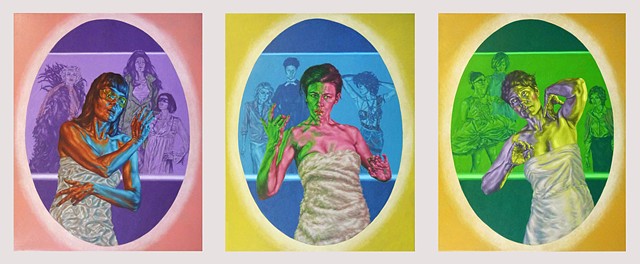NEON
The male gaze, as defined by film theorist Laura Mulvey in her 1975 essay ‘Visual Pleasure and Narrative Cinema’, is tripartite: a triangular relationship between the camera, the characters being filmed, and the audience watching the final work. Although she was talking specifically about film, Mulvey’s term has become equally common parlance in relation to the traditional male canon in the history of art, whereby the gaze of the male artist stands in a triangular relationship to the – typically nude and generally objectified – female model, as well as to the returned gaze of the (male) viewer. The term ‘female gaze’ has been coined in response to its male counterpart to define the chasm in the canon where art made by, and indeed for, women ought to sit. But is the female gaze really just the opposite of the male?
In her essay ‘The Laugh of the Medusa’, also written in 1975, the French theorist Hélène Cixous put forward the concept of écriture feminine, stating: ‘Woman must write herself: must write about women and bring women to writing, from which they have been driven away as violently as from their bodies’. Might one then not equally posit a visual equivalent, such that: ‘Woman must paint herself, must paint women and bring women to painting, from which they have been driven away as violently as from their bodies’?
This is, to a great extent, the goal of the THREESOME series, and the exhibition of that title for which this series was painted, devised by Roxana Halls, Sadie Lee and Sarah Jane Moon, which launched at New Art Projects, London and subsequently toured to The Gallery, Liverpool with the support of Arts Council, England in 2018.
The title of this exhibition, THREESOME was chosen with every ounce of eroticism strictly intended.
The pioneering lesbian photographer J.E.B (Joan E Biren) wrote in 1983: ‘Without a visual identity, we have no community, no support network, no movement. Making ourselves visible is a political act. Making ourselves visible is a continual process.’ And, nearly three and a half decades later, this process is ongoing, vital but, sadly, still largely lacking.
The female gaze, as much as it can be theorised academically, is also, at its heart, about allowing the space and freedom to see differently. Accordingly, within the basic framework of the exhibition – namely that each artist should paint herself, the other two artists, and a nude model selected as a group – Halls, Lee and Moon gave themselves free rein to proceed according to their own aesthetic, compositional and conceptual wishes. As such, the finished exhibition, at once a cohesive whole, might also be seen as comprising various subsets of three: the three nudes, the three self-portraits, and the three portraits of each artist. As such, this notion of the tripartite also plays out at every level.
Halls’ THREESOME paintings employ their own adroit strategies of resistance to the tired tropes of female representation. The flesh tones of her heroic protagonists have been denatured by a saturation of neon colour, their stylised gestures all uncannily performative, frozen in a gestural polari. Each is flanked by a triumvirate of characters from a very specific history of queer cinema, that of the lesbian as seen by male directors. The actresses who played these roles have been replaced by mannequins who are mere approximations of the original women. Thus, questions about authenticity and spectatorship circulate these iconographic portraits.
